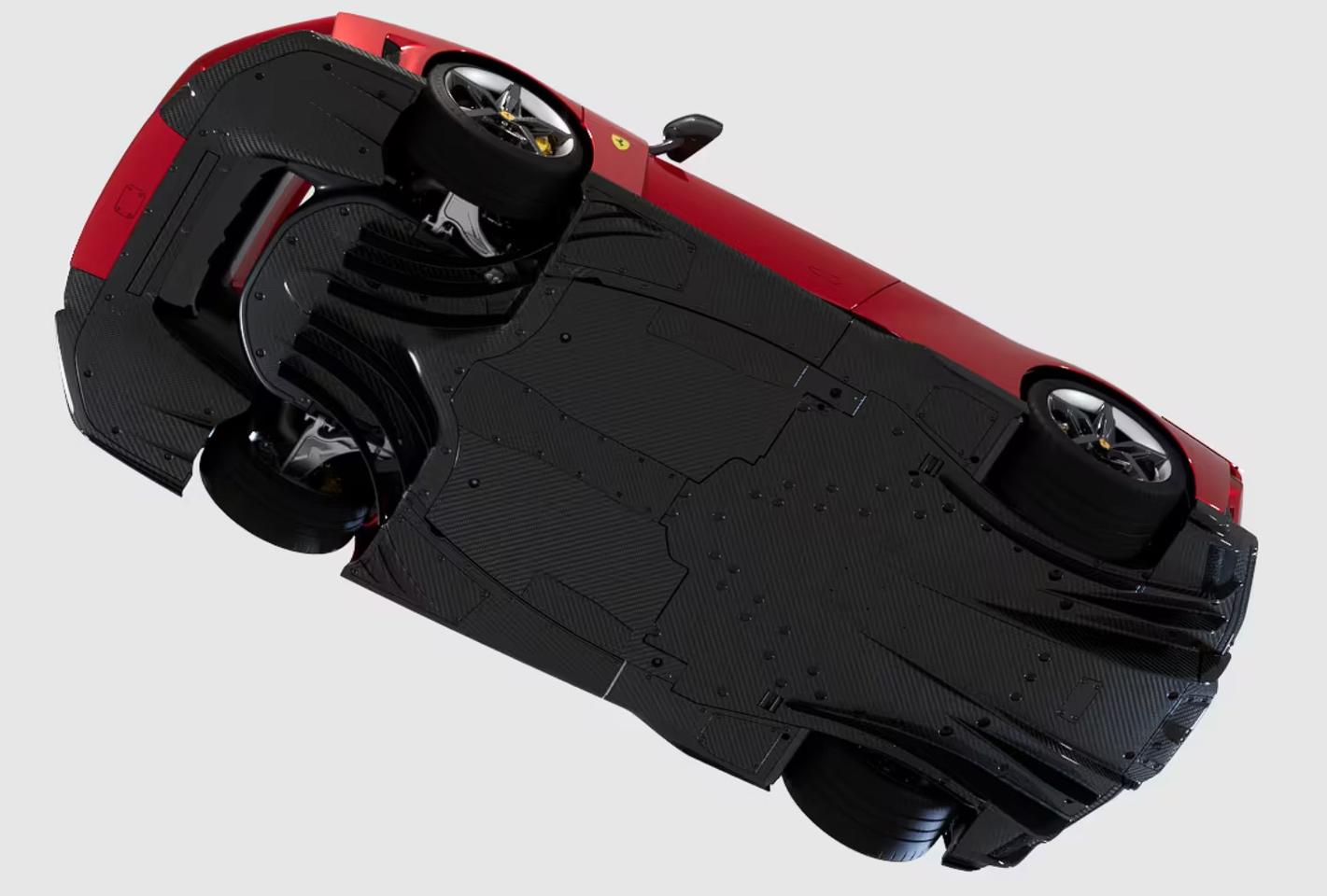Ferrari’s new F80 hypercar has tongues wagging about the new design language, and whether it’ll make for a suitable successor to the 2013 LaFerrari. What’s probably more important, though, is that the Maranello-based marque’s latest creation can get from 0-62 mph in just 2.15 seconds, and hit a top speed of 217 mph (350 km/h).
There’s a lot going on under the hood – and under the chassis – to make that happen. Let’s walk through four of the most notable characteristics that make this the most powerful road car Ferrari has ever made.
1) Engine
Naturally, we’ll start with the drivetrain. You’ve got a 3-L twin-turbo V6 hybrid engine putting out 900 hp. It’s based on the one in the 296 GTB from 2021 – but it makes 237 hp more while weighing the same. That’s thanks to “a new approach for statistical knock control, which lets the engine operate even closer to the knock limit, allowing the use of higher combustion chamber pressures than ever.”

Ferrari
That mill is supported by five electric motors:
- One electric motor at the back powering the rear wheels.
- Two electric motors at the front for the front wheels.
- Two electric motors to spin up dual turbos without lag.
All in all, you get a heart-stopping 1,200 hp, 627 lb.ft (850 Nm) of torque, and a rev limit of 9,200 RPM from this beastly all-wheel drive system.
Introducing the Ferrari F80
2) Weight reduction
As you’d expect, a whole lot of engineering went into reducing the car’s weight from nose to tail:
- The chassis and bodyshell are largely made from carbon fiber, coupled with aluminum components.
- 3D-printed elements in the suspension’s active inboard dampers and upper wishbones for reduced unsprung mass.
- Carbon fiber monocoque casing for the battery pack.
- Optimized crankshaft webs, counterweights, and aluminum pistons for weight savings in the powertrain.

Ferrari
These and other design decisions bring the F80’s dry weight to an impressively low 3,363 lb (1,525 kg).
3) Aerodynamics
The F80 has several F1-inspired aerodynamic elements that work in tandem to generate a dizzying 2,205 lb (1,000kg) of downforce at 155 mph (250 km/h). You’ll notice an active active rear wing that changes its position and angle to increase downforce and reduce drag.

Ferrari
The vehicle’s design features a flat underbody and rear diffuser capable of handling a massive flow of air beneath the car. Towards the nose, there’s a front triplane wing, and a large S-duct with adaptive flaps built into the carbon fiber front hood to help things along. In addition, active suspension can lower the car closer to the ground for increased downforce.

Ferrari
4) Boost Optimization
There’s one last treat for drivers who enjoy track days. The F80’s Boost Optimization feature records data about the circuit’s curves and straights when you take a reconnaissance lap; on subsequent laps, it delivers extra power in sections where you need it most.
In Performance mode, the car “maintains constantly available performance for as long as possible.” In Qualify mode, it’ll generate as much power as it can muster, at the cost of a drop in high-voltage battery charge.
Facing off against its nemesis
So how does the newest Ferrari fare against the competition? McLaren’s V8-powered W1 is one of its mostly closely matched opponents, with similar power and top speed figures. However, comparing their other specs reveals a rather interesting rivalry.

McLaren
If you look at the power-to-weight ratio, the W1 beats the F80 hollow: 911 hp/ton versus 787 hp/ton. That’s not a typo: McLaren’s hypercar is ridiculously light at just 3,084 lb (1,399 kg).
That should make the W1 quicker off the line, right? Surprisingly, the F80 does 0-62 mph quicker at 2.15 seconds than the W1’s 2.7 seconds – and you can chalk that up to the former’s all-wheel drive system.
Now, if you look at 0-124 mph (200 km/h), the two are nearly neck and neck. The F80 leads by a whisker at 5.75 seconds, compared to the W1’s 5.8 seconds. As Carwow notes, it’s likely the latter’s higher power-to-weight ratio closing the gap.
If that close competition is making you anxious about which one to choose, don’t sweat it. Only 799 examples of the US$3.9 million F80 will be produced – and like the W1’s 399 units, they’re already sold out.

Ferrari
You can, however, still play millionaire auto enthusiast and fiddle with the F80 configurator on Ferrari’s website. Gotta choose your seat belt color wisely, right?
Source: Ferrari
Source of Article